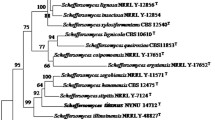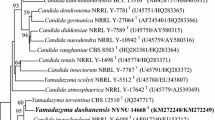Abstract
Two yeast strains representing a hitherto undescribed yeast species were isolated from olive oil and spoiled olive oil originating from Spain and Israel, respectively. Both strains are strong acetic acid producers, equipped with considerable tolerance to acetic acid. The cultures are not short-lived. Cellobiose is fermented as well as several other sugars. The sequences of their large subunit (LSU) rRNA gene D1/D2 domain are very divergent from the sequences available in the GenBank. They differ from the closest hit, Brettanomyces naardenensis by about 27%, mainly substitutions. Sequence analyses of the concatenated dataset from genes of the small subunit (SSU) rRNA, LSU rRNA and translation elongation factor-1α (EF-1α) placed the two strains as an early diverging member of the Brettanomyces/Dekkera clade with high bootstrap support. Sexual reproduction was not observed. The name Brettanomyces acidodurans sp. nov. (holotype: NCAIM Y.02178T; isotypes: CBS 14519T = NRRL Y-63865T = ZIM 2626T, MycoBank no.: MB 819608) is proposed for this highly divergent new yeast species.


Similar content being viewed by others
References
Aiello A, Accardi G, Candore G, Carruba G, Davinelli S, Passarino G, Scapagnini G, Vasto S, Caruso C (2016) Nutrigerontology: a key for achieving successful ageing and longevity. Immun Ageing. doi:10.1186/s12979-016-0071-2
Angerosa F, Lanza B, Marsilio V (1996) Biogenesis of « fusty » defect in virgin olive oils. Grasas Aceites 47:142–150
Barnett JA, Payne RW, Yarrow D (2000) Yeasts: characteristics and identification, 3rd edn. Cambridge Univ. Press, Cambridge
Buckland G, González CA (2010) Trends in Olive Oil Production, Supply and Consumption in Mediterranean Countries from 1961 to the Present Day. In: Preedy VR, Watson RR (eds) Olives and Olive Oil in Health and Disease Prevention. Academic Press, San Diego, pp 689–698. doi: http://dx.doi.org/10.1016/B978-0-12-374420-3.00072-3
Čadež N, Raspor P, Turchetti B, Cardinali G, Ciafardini G, Veneziani G, Péter G (2012) Candida adriatica sp. nov. and Candida molendinolei sp. nov., two yeast species isolated from olive oil and its by-products. Int J Syst Evol Microbiol 62:2296–2302
Čadež N, Dlauchy D, Raspor P, Péter G (2013) Ogataea kolombanensis sp. nov., Ogataea histrianica sp. nov. and Ogataea deakii sp. nov., three novel yeast species from plant sources. Int J Syst Evol Microbiol 63:3115–3123
Cayuela JA, Gómez-Coca RB, Moreda W, Pérez-Camino MC (2015) Sensory defects of virgin olive oil from a microbiological perspective. Trends Food Sci Tech 43:227–235
Ciafardini G, Zullo BA (2002) Microbiological activity in stored olive oil. Int J Food Microbiol 75:111–118
Ciafardini G, Zullo BA, Iride A (2006a) Lipase production by yeasts from extra virgin olive oil. Food Microbiol 23:60–67
Ciafardini G, Zullo BA, Cioccia G, Iride A (2006b) Lipolytic activity of Williopsis californica and Saccharomyces cerevisiae in extra virgin olive oil. Int J Food Microbiol 107:27–32
Ciafardini G, Zullo BA, Antonielli L, Corte L, Roscini L, Cardinali G (2013) Yamadazyma terventina sp. nov., a yeast species of the Yamadazyma clade from Italian olive oils. Int J Syst Evol Microbiol 63:372–376
Cicerale S, Lucas LJ, Keast RSJ (2012) Antimicrobial, antioxidant and anti-inflammatory phenolic activities in extra virgin olive oil. Curr Opin Biotech 23:129–135
Deák T (2008) Handbook of food spoilage yeasts, 2nd edn. CRC Press, Boca Raton, p 325
Edgar RC (2004) MUSCLE: multiple sequence alignment with high accuracy and high throughput. Nucleic Acids Res 32:1792–1797
Felsenstein J (1985) Confidence limits on phylogenies: an approach using the bootstrap. Evolution 39:783–791
Freer SN (2002) Acetic acid production by Dekkera/Brettanomyces yeasts. World J Microb Biot 18:271–275
Jutakanoke R, Endoh R, Takashima M, Ohkuma M, Tanasupawat S, Akaracharanya A (2016) Allodekkera sacchari, gen. nov., sp. nov., a novel yeast species in the Saccharomycetales isolated from a sugar factory in Thailand. Int J Syst Evol Microbiol. doi:10.1099/ijsem.0.001607
Koidis A, Triantafillou E, Boskou D (2008) Endogenous microflora in turbid virgin olive oils and the physicochemical characteristics of these oils. Eur J Lipid Sci Technol 110:164–171
Kotzekidou P (1997) Identification of yeasts from black olives in rapid system microtitre plates. Food Microbiol 14:609–616
Kurtzman CP (2003) Phylogenetic circumscription of Saccharomyces, Kluyveromyces and other members of the Saccharomycetaceae, and the proposal of the new genera Lachancea, Nakaseomyces, Naumovia, Vanderwaltozyma and Zygotorulaspora. FEMS Yeast Res 4:233–245
Kurtzman CP, Robnett CJ (2013) Relationships among genera of the Saccharomycotina (Ascomycota) from multigene phylogenetic analysis of type species. FEMS Yeast Res 13:23–33
Kurtzman CP, Robnett CJ, Basehoar-Powers E (2008) Phylogenetic relationships among species of Pichia, Issatchenkia and Williopsis determined from multigene sequence analysis, and the proposal of Barnettozyma gen. nov., Lindnera gen. nov and Wickerhamomyces gen. nov. FEMS Yeast Res 8:939–954
Kurtzman CP, Fell JW, Boekhout T, Robert V (2011) Methods for isolation, phenotypic characterization and maintenance of yeasts. In: Kurtzman CP, Fell JW, Boekhout T (eds) The yeasts, a taxonomic study, 5th edn. Elsevier, Amsterdam, pp 97–107
Lee K-Y, So J-S, Heo T-R (2000) Thin layer chromatographic determination of organic acids for rapid identification of bifidobacteria at genus level. J Microbiol Meth 45:1–6
McNeill J, Barrie FR, Buck WR, Demoulin V, Greuter W, Hawksworth DL, Herendeen PS, Knapp S, Marhold K, Prado J, Prud’homme Van Reine WF, Smith GF, Wiersema JH, Turland NJ (2012) International code of nomenclature for algae, fungi, and plants (Melbourne Code). Koeltz scientific books. http://www.iapt-taxon.org/nomen/main.php. Accessed 09 August 2016
Reis ALS, Rodrigues de Souza RF, Torres RRNB, Leite FCB, Paiva PMG, Vidal EE, de Morais MA (2014) Oxygen-limited cellobiose fermentation and the characterization of the cellobiase of an industrial Dekkera/Brettanomyces bruxellensis strain. SpringerPlus 3:38. doi:10.1186/2193-1801-3-38
Smith MTH (2011a) Dekkera van der Walt (1964). In: Kurtzman CP, Fell JW, Boekhout T (eds) The Yeasts, a Taxonomic Study, 5th edn. Elsevier, Amsterdam, pp 373–377
Smith MTH (2011b) Brettanomyces kufferath. In: Kurtzman CP, Fell JW, Boekhout T (eds) The yeasts, a taxonomic study, 5th edn. Elsevier, Amsterdam, pp 983–986
Steensels J, Daenen L, Malcorps P, Derdelinckx G, Verachtert H, Verstrepen KJ (2015) Brettanomyces yeasts—from spoilage organisms to valuable contributors to industrial fermentations. Int J Food Microbiol 206:24–38
Tamura K, Stecher G, Peterson D, Filipski A, Kumar S (2013) MEGA6: molecular evolutionary genetics analysis version 6.0. Mol Biol Evol 30:2725–2729
Thompson JD, Gibson TJ, Plewniak F, Jeanmougin F, Higgins DG (1997) The ClustalX windows interface: flexible strategies for multiple sequence alignment aided by quality analysis tools. Nucleic Acids Res 24:4876–4882
White TJ, Bruns T, Lee S, Taylor J (1990) Amplification and direct sequencing of fungi ribosomal RNA genes for phylogenetics. In: Innis MA, Gelfalnd DH, Sninsky JJ, White TT (eds) PCR protocols. Academic Press, San Diego, A guide to methods and applications, pp 315–322
Zullo BA, Cioccia G, Ciafardini G (2013) Effects of some oil-born yeasts on the sensory characteristics of Italian virgin olive oil during its storage. Food Microbiol 36:70–78
Acknowledgement
This study was partly supported by the State Secretariat for Higher Education, Hungarian Ministry of Human Resources and from the Slovenian Research Agency (P4-0116 and MRIC-UL ZIM, IP-0510). We thank Gusztáv Tóth (Olive Oil Specialty Shop, Pomáz, Hungary) for providing olive oil samples and valuable information and Rikiya Endoh, Japan Collection of Microorganisms, Tsukuba, Japan, for providing us with the type strain of Allodekkera sacchari.
Author information
Authors and Affiliations
Corresponding author
Electronic supplementary material
Below is the link to the electronic supplementary material.
Rights and permissions
About this article
Cite this article
Péter, G., Dlauchy, D., Tóbiás, A. et al. Brettanomyces acidodurans sp. nov., a new acetic acid producing yeast species from olive oil. Antonie van Leeuwenhoek 110, 657–664 (2017). https://doi.org/10.1007/s10482-017-0832-8
Received:
Accepted:
Published:
Issue Date:
DOI: https://doi.org/10.1007/s10482-017-0832-8




